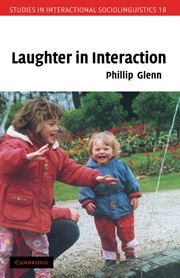Book contents
- Frontmatter
- Contents
- List of figures and tables
- Acknowledgments
- Transcription symbols
- Introduction
- 1 Towards a social interactional approach to laughter
- 2 Conversation analysis and the study of laughter
- 3 Laughing together
- 4 Who laughs first
- 5 Laughing at and laughing with: negotiating participant alignments
- 6 Laughing along, resisting: constituting relationship and identity
- 7 Closing remarks
- Notes
- References
- Index
1 - Towards a social interactional approach to laughter
Published online by Cambridge University Press: 08 August 2009
- Frontmatter
- Contents
- List of figures and tables
- Acknowledgments
- Transcription symbols
- Introduction
- 1 Towards a social interactional approach to laughter
- 2 Conversation analysis and the study of laughter
- 3 Laughing together
- 4 Who laughs first
- 5 Laughing at and laughing with: negotiating participant alignments
- 6 Laughing along, resisting: constituting relationship and identity
- 7 Closing remarks
- Notes
- References
- Index
Summary
This book is about laughter as a part of everyday human communication. The central focus of subsequent chapters concerns sequential organization of laughter in interaction, what people do with and through laughter, and the ways laughter plays a part in constituting identities and relationships. These topics foreground laughter as communication and as fundamentally social. They represent a shift in emphasis from previous research that has given greater emphasis to its physical, biological, philosophical, and psychological dimensions. Specifically, this book addresses three general questions:
How do people accomplish laugher in everyday interaction? That is, how is laughter organized, produced, and interpreted?
How do people laugh together? How is shared laughter brought about, maintained, or closed?
What do people accomplish through laughter in interaction?
These questions represent something of a departure from much previous research on laughter. However, they reflect grounding in over twenty-five years of conversation analytic investigations into the sequential organization and interactional workings of everyday laughter, and those materials are reviewed in detail beginning in Chapter 2. In this chapter I provide an overview of some ways laughter has been regarded and studied, thereby positioning this book as building on, and to some extent contrasting with, what has gone before. The familiar but enigmatic phenomenon of laughter has long drawn the fascination and interest of scholars of nearly every academic discipline (for other related reviews, see Monro, 1963; Hertzler, 1970; Goldstein and McGhee, 1972; Holland, 1982; Morreall, 1983; Zijderveld, 1983; Norrick, 1993; Foot, 1997; and Provine, 2000).
- Type
- Chapter
- Information
- Laughter in Interaction , pp. 7 - 34Publisher: Cambridge University PressPrint publication year: 2003
- 1
- Cited by



